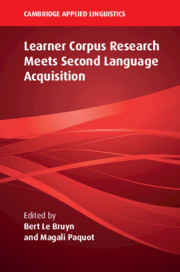Book contents
- Learner Corpus Research Meets Second Language Acquisition
- The Cambridge Applied Linguistics Series
- Learner Corpus Research Meets Second Language Acquisition
- Copyright page
- Contents
- Figures
- Tables
- Contributors
- Series Editors’ Preface
- Learner Corpus Research and Second Language Acquisition: an attempt at bridging the gap
- Article Use in Russian and Spanish Learner Writing at CEFR B1 and B2 Levels: Effects of Proficiency, Native Language, and Specificity
- L1 Influence vs. Universal Mechanisms: An SLA-Driven Corpus Study on Temporal Expression
- The Interplay between Universal Processes and Cross-Linguistic Influence in the Light of Learner Corpus Data: Examining Shared Features of Non-native Englishes
- Exploring Multi-Word Combinations as Measures of Linguistic Accuracy in Second Language Writing
- Using Syntactic Co-occurrences to Trace Phraseological Complexity Development in Learner Writing: Verb + Object Structures in LONGDALE
- Understanding the Long-Term Evolution of L2 Lexical Diversity: The Contribution of a Longitudinal Learner Corpus
- L2 Developmental Measures from a Dynamic Perspective
- Exploring Individual Variation in Learner Corpus Research: Methodological Suggestions
- Building an Oral and Written Learner Corpus of a School Programme: Methodological Issues
- Commentary: Have Learner Corpus Research and Second Language Acquisition Finally Met?
- Commentary: An SLA Perspective on Learner Corpus Research
- Index
- References
Commentary: An SLA Perspective on Learner Corpus Research
Published online by Cambridge University Press: 29 December 2020
- Learner Corpus Research Meets Second Language Acquisition
- The Cambridge Applied Linguistics Series
- Learner Corpus Research Meets Second Language Acquisition
- Copyright page
- Contents
- Figures
- Tables
- Contributors
- Series Editors’ Preface
- Learner Corpus Research and Second Language Acquisition: an attempt at bridging the gap
- Article Use in Russian and Spanish Learner Writing at CEFR B1 and B2 Levels: Effects of Proficiency, Native Language, and Specificity
- L1 Influence vs. Universal Mechanisms: An SLA-Driven Corpus Study on Temporal Expression
- The Interplay between Universal Processes and Cross-Linguistic Influence in the Light of Learner Corpus Data: Examining Shared Features of Non-native Englishes
- Exploring Multi-Word Combinations as Measures of Linguistic Accuracy in Second Language Writing
- Using Syntactic Co-occurrences to Trace Phraseological Complexity Development in Learner Writing: Verb + Object Structures in LONGDALE
- Understanding the Long-Term Evolution of L2 Lexical Diversity: The Contribution of a Longitudinal Learner Corpus
- L2 Developmental Measures from a Dynamic Perspective
- Exploring Individual Variation in Learner Corpus Research: Methodological Suggestions
- Building an Oral and Written Learner Corpus of a School Programme: Methodological Issues
- Commentary: Have Learner Corpus Research and Second Language Acquisition Finally Met?
- Commentary: An SLA Perspective on Learner Corpus Research
- Index
- References
Summary
There have been repeated calls over the years for greater interaction between Second Language Acquisition (SLA) research and Learner Corpus Research (LCR), including by myself and the editors of this volume, as well as many others (e.g. Granger et al. 2015; Lozano & Díaz-Negrillo 2019; Lozano & Mendikoetxea 2010; McEnery et al. 2019). In a range of publications (Myles 2005, 2007, 2008, 2015; Myles & Mitchell 2004), I have outlined, from an SLA perspective, what I perceive to be the gaps to be bridged in order for the two fields to be engaged in useful collaboration. My task with this commentary is to assess how far these gaps have narrowed, on the basis of the chapters in this volume.
- Type
- Chapter
- Information
- Learner Corpus Research Meets Second Language Acquisition , pp. 258 - 273Publisher: Cambridge University PressPrint publication year: 2021

